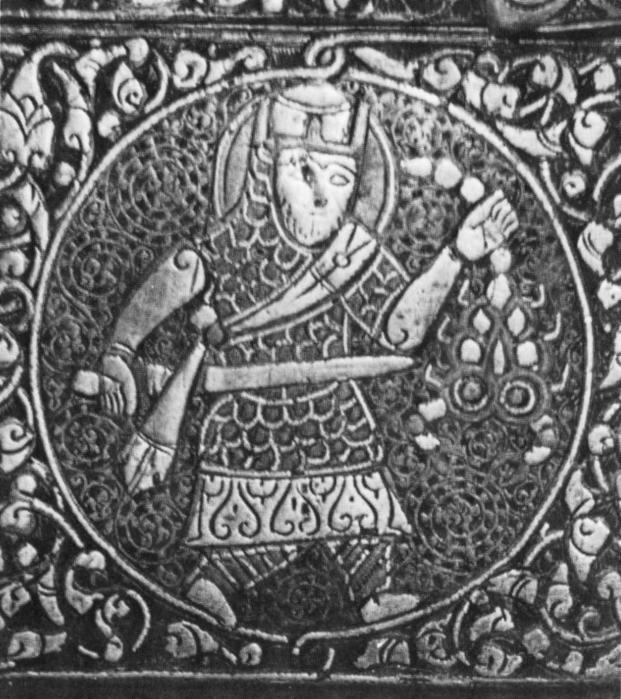
Find the perfect fit with Amazon Prime. Try Before You Buy.
A pen-box from Mosul, 1230-1250AD

Source: British Museum 1884,0704.85
Scorpio on a pen-box from Mosul, 1230-1250AD
[or Mars in Conjunction with Scorpio]




Inlaid brass writing box showing 'Scorpio' wearing a mail hauberk, from Mosul AD 1200-1250. (Franks Bequest, British Mus., London)
Source: p.14, MAA - 171 - Saladin and the Saracens by David Nicolle
Description: The sides of the box are decorated with twelve roundels containing personifications of the planets in their day or night houses. Scenes along the front include (from right to left): Mars in Aries (a warrior holding a sword and riding a ram); Venus in Taurus (a lute-player riding a bull); Mercury in Gemini (two figures holding a staff); the Moon in Cancer (a cross-legged figure holding a crescent before her face); the Sun in Leo (a figure with the face of the sun riding a lion); Mercury in Virgo ( two figures holding ears of corn)." (from Compass entry July 24, 2006) Blurton, 1997:
Its astrological imagery is comparable to the scheme used on the Vaso Vescovali (1950.0725.1).
Date: 1230-1250
Production place: Made in: Mosul (Asia, Iraq, North Iraq)
Dimensions: Width: 9 centimetres Length: 36.8 centimetres
Curator's comments: Inlaid with a verse from the Qur'an and symbols of the planets and the zodiac
The pen-box has a long section for pens, with smaller containers at one end for ink, sand (for blotting the ink) and threads (for cleaning the reed-pens). The Arab historian Qalqashandi, claimed that large square-ended pen-boxes like this were often used by treasury scribes because they could put a supply of accounting paper in the lid. He also wrote: 'know that it is necessary for the scribe to do his utmost to adorn the pen-box, to make it excellent and to look after it.' The owner of this pen-box has chosen to adorn the inside of the lid with a finely written verse from the Qur'an (11:88): 'I desire only to set things right so far as I am able. My succour is only with God; in Him I have put my trust.'
Referenced as figure 288 in The military technology of classical Islam by D Nicolle
288. Inlaid metal writing box, early 13th century AD, Jazīrah, British Museum, Franks Bequest, London (Elg).
p.175: A certain amount of confusion could surround mail. Its rings were widely referred to in Arabic as zard, zared or zird, which is a term very close to the sard scales of the dirʿ. There does, however, seem to have been a clear distinction between the two terms from the 10th to 14th centuries (see Terminology). The situation in Persian-speaking areas was simpler, for here the term zirih quite clearly referred to mail.43 The pictorial evidence, some of it very stylized and having to be interpreted with caution, shows that mail hauberks of various shapes, long (Figs. 330, 333, 335, 447, 501, 520, 537, 543, 600, and 639) or short (Figs. 134, 196, 246, 267, 292, 294, 305, 392, 515, 522, 541, 598 and 599), with long (Figs.161, 174, 241, 250, 270, 298, 305, 345, 346, 347, 348, 350, 375, 428, 435, 438, 442, 494, 500, 519, 535, 538, 540, 543, 545A-F and H, and 551B) or short sleeves (Figs. 262, 286, 288, 292, 339, 444, 446, 499, 521, 546A, 551, 601, 606, and 661), some opening down the front (Figs. 324F and 641) and others put on over the head (Figs. 157, 316, 377, 422, 517, and 549), were all used in most regions of Islam in most periods.44
43. Firdawsī, op. cit., pp. 368-369, 427 and 828.
44. Fries, op. cit., pp. 62-63; Anon., The Song of Roland, verse 79; Ibn Isḥag, op. cit., p. 107; Mutanabbi, in Wormhoudt, op. cit., p. 84; Norris, op. cit., pp. 95-96.